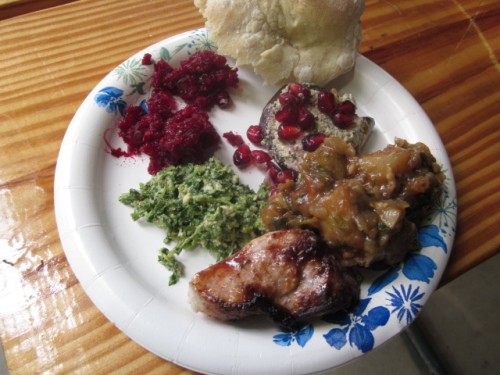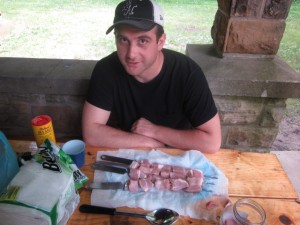By Mr. Augie
Mr. Augie and Mrs. Annie hosted a family picnic in Alliance, Ohio on Saturday, Independence weekend. Much to our surprise, a special meal was prepared and served–before our American barbequed 5.5 pound pastured chicken, potato salad and baked beans.
There is spiritual meaning to natural food and drink, a communion among family and friends. Having several authentically traditional Republic of Georgia cuisine specially prepared for you table-side surrounded by nature is one thing, but having it prepared by newlyweds Shota Gagaidze and Laife Janovyak recent arrivals from the Republic makes it a most memorable feast for the family. Georgia was once part of the USSR but now have their independence.

Shota preparing the mtsvadi
Chatting in Shota’s native tongue, the two unpacked a couple bags of fresh grocs (that’s an English truncation for groceries) from Cleveland’s famed, open air West Side Market, the oldest in the U.S. The prep began by lighting the coals. In Georgia fresh meat (slaughtered that day!) is grilled over wood often with grape vines added for aroma.

Laife making the salad
The meat course was mtsvadi, simply fresh butchered pork cubes, marinated in red wine and onions, heavily seasoned with ground pepper and sea salt, grilled close over hot coals on spits, turning frequently until crisp and somewhat charred. Shota was on the grill of course. They had taken a jar of marinade to the market for the butcher to fill, typically this should marinate several hours or overnight.

badrijan migvzit
Sides were vegetable stew called apopsadali, a room temperature potato-based dish, badrijan migvzit, exquisite fried eggplant pieces with a heavy topping of roasted garlic paste and pomegranate; also a blended beet dish called carkhala salad or ჭარხლის სალათა (there’s a word I know!); prasa salad, a leek salad; and some home-made bread called khatchpori, a very flat pita-type bread baked with a center of salty cheese. Drink was a sweetened cream cold coffee, and red wine. Georgians usually drink a very strong, sweet Turkish coffee. (Regular Folger’s was served with raw milk).
By the way, Georgia is the oldest wine producing region of the world. The fertile valleys of the South Caucasus, which Georgia straddles, are believed by many archaeologists to be the source of the world’s first cultivated grapevines and neolithic wine production, over 8,000 years ago–see Wikipedia. Also, the beloved kefir grains are believed to originate in the Caucasus mountains. A very rich heritage indeed!

Laife and Shota sampling the freshly butchered pork
Laife told the story of a three-day travel delay causing her to miss her wedding twice before arriving in Tbilisi from California. It was many months before Shota’s paperwork allowed him to come to the States last fall. They met while Laife was a Peace Corps volunteer which ended in her escape from Georgia during the Russian bombing a couple years ago.
Wish Laife and Shota a life of joyous marriage by commenting; perhaps leaving a traditional, nutrient-dense recipe of your ethnic heritage using farm/garden fresh ingredients.
I still cannot pronounce their last name—but salad was the one word I could understand. Besides that, I did learn the letter T, it sounds like taw—I think.

Here's part of the clan. Laife is to my right, next to Shota. Mrs. Annie is front left, next to Grandma Geri. All ten of our nephews and nieces were homeschooled. That's me in the straw hat again.
Deuteronomy 8:19– When thou hast eaten and art full, then thou shalt bless the Lord thy God for the good land which He hath given thee.
Genrielad Meertvit
კარგი ჭამა
(Good eating, as in Bon Apetit)
__________________________________
 Eat Away Your Acid Reflux. Over 60 million Americans suffer acid-reflux disorder, now epidemic. Recover from GERD with this eBook! Read all about it and watch the short video.– Mr. Augie
Eat Away Your Acid Reflux. Over 60 million Americans suffer acid-reflux disorder, now epidemic. Recover from GERD with this eBook! Read all about it and watch the short video.– Mr. Augie






Yogurt is made world over–this is taken from the 60 raw milk recipe contest hosted here at the Journal. See them https://wholefoodusa.wordpress.com/2010/12/01/raw-milk-recipe-contest/
This one is from Mrs. Annie
Yogurt
(Makes 2 Quarts)
There are several ways to make yogurt. The idea is to gently heat the milk, add the culture and allow it to sit in a warm place for 8-10 hours or more. The milk shouldn’t be heated above 113 degrees or you start killing off the good bacteria—the very purpose of making your own yogurt. For this reason, avoid the crockpot method. A warm place for the yogurt to sit can be your oven with only the light on, a dehydrator; some use their kitchen counter on a very hot day. In the interest of consistency, I use a picnic cooler filled with water at about 90-100 degrees. The water should reach just under the necks of the jars.
You’ll need:
Double boiler (I use a large skillet with a dutch oven sitting atop!)
Candy thermometer
Funnel
2 quart-sized mason jars with lids (any lid is fine; I use plastic ones)
Small bowl
Ladle
A little less than 2 quarts milk
2 Tablespoons yogurt from previous batch OR a good quality plain yogurt
Heat the milk slowly in double boiler. Meanwhile fill your cooler with the warm water. The easy way to get the temperature right is to hold the candy thermometer under the running tap water. Keep it running as you fill the cooler using a quart sized measure; you’ll need about 11 quarts of water.
Put the 2 tablespoons yogurt in the small bowl and set aside.
Stirring the milk occasionally, take it off heat when it reaches about 110, as it may climb up a bit. Ladle a small amount of the heated milk into the yogurt to temper it. Stir well. Keep adding small amounts, stirring after each until it’s quite warm. Then add to the big pan of milk stirring thoroughly.
Place the funnel over a mason jar and pour the mixture filling the jar up to the threads. Repeat with the other jar. Place the lids on the jars and put them in the cooler. Adjust your water depth if necessary. I use a cup with a spout to add or remove a little.
Close the cooler. I like to put some folded blankets or tablecloths on top to help keep in the heat.
That’s it! Don’t be picky about the time: 8 hours, 10 hours, 15 hours—the yogurt will be fine. I make it in the afternoon and refrigerate it in the morning.
Once cooled, stir it to mix in some of the butterfat that rises to the top. If you find the yogurt too thin for your taste, strain it using a coffee filter (or cheesecloth) in a strainer over a bowl. I love to do this since it yields wonderful whey for lacto-fermented foods! (See Bulletin #1) You can strain this for several hours at room temperature, but do not stir it while it’s straining! Also, you can cover this while straining and refrigerate it overnight—you’ll get the very best cream cheese you’ve ever had. This cream cheese remains a spreadable consistency right from the fridge.
Great article.
I bake my own bread and often I make tuscan bread with whole wheat flour and fennel seed.
I have a friend who just went over to teach English in the Republic of Georgia, she says she is having a great time eating over there 🙂
Unrelatedly, do you accept guest posts? Drop me an e-mail at patwalling86 at gmail, thanks!